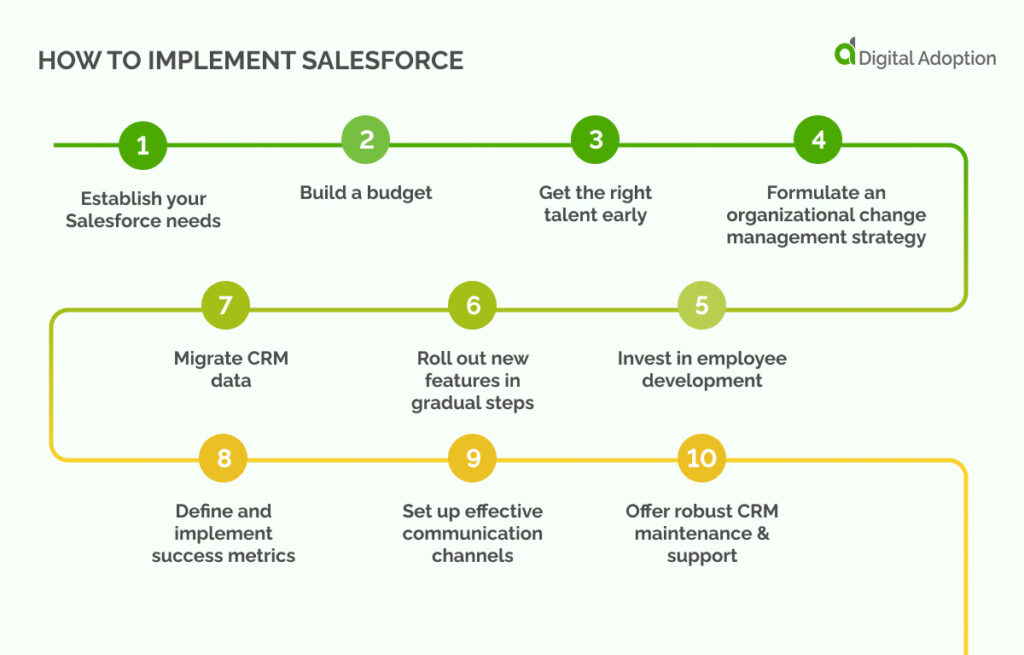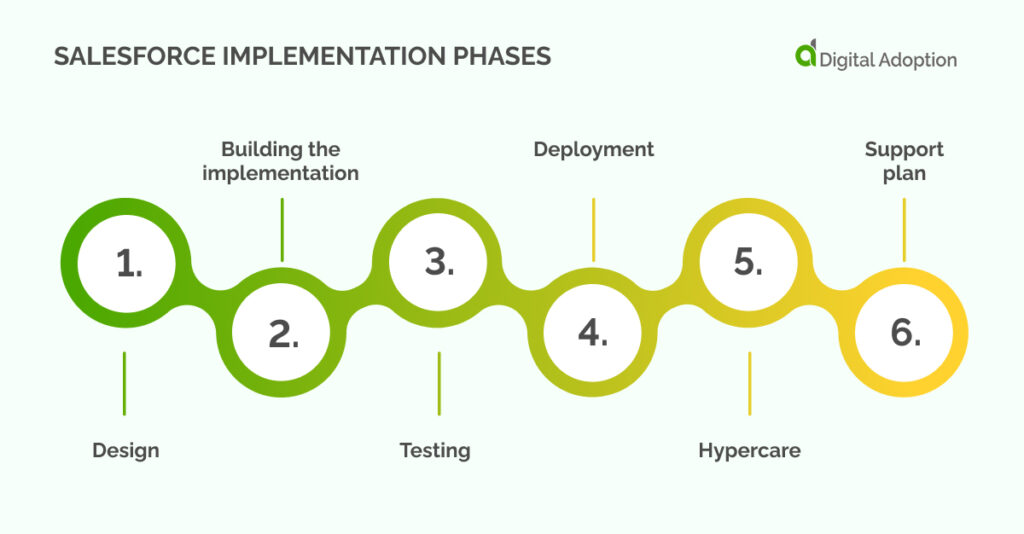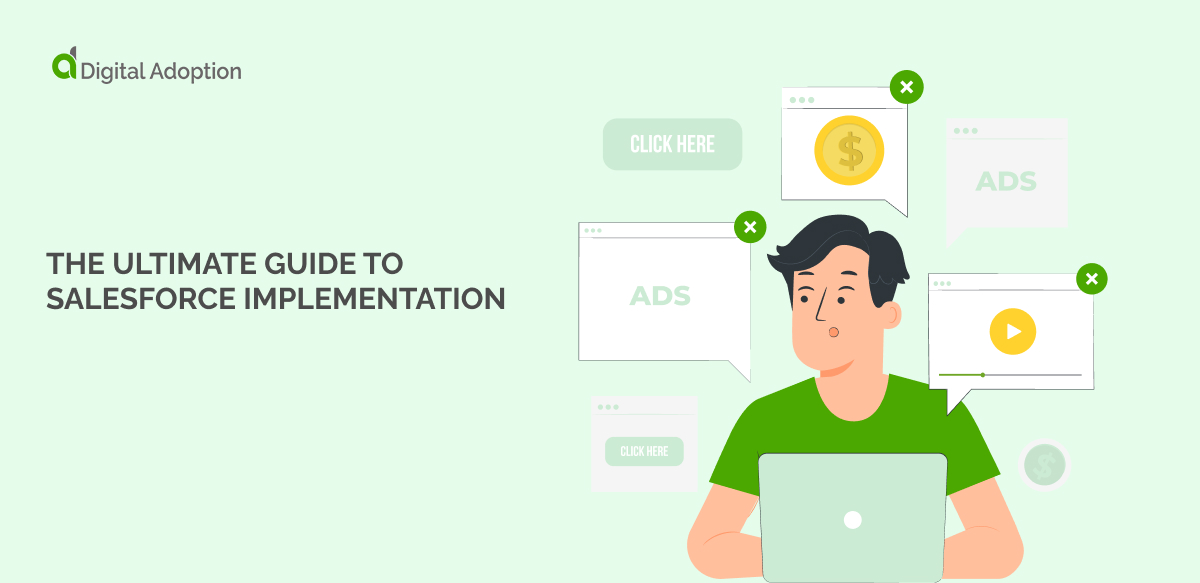Salesforce is a powerful CRM tool for global sales teams, especially in the US. It allows organizations to interact effectively with customers to meet and predict their needs.
In 2023, Salesforce CRM had a global market share of 21.7%, making it the number one CRM available. Given these statistics, it’s impossible not to consider how to implement it successfully as part of a digital transformation to compete against others pushing for sales.
Salesforce has many different products that meet various enterprise needs. Sales Cloud, Revenue Cloud, Marketing Cloud, Pardot, and Service Cloud are just a few. When you learn to implement Salesforce via homegrown CRM implementation or an external agency, your sales department will become more efficient, leading to more sales and higher forecast accuracy.
This article begins by defining Salesforce implementation. It then moves on to why you should implement this CRM, how to implement Salesforce, and finally, the phases of this popular CRM.
After finishing this article, you will know how to implement Salesforce efficiently and without waste as you decode and unlock the secrets of successful Salesforce adoption. Sales teams will thank you as you generate sales and increase success for higher revenue.
What is Salesforce implementation?
Salesforce implementation involves embedding the Salesforce CRM software into your sales department and gaining its benefits for your organization. The process includes customizing the CRM for your needs by configuring features, integrating with other systems, migrating data, and training users.
This process optimizes the Salesforce platform for improved business processes and efficiency. It also enhances sales and revenue.
Why should you implement Salesforce?
The Salesforce market in North America, its biggest market, has grown over the last three years from USD 17.9 billion in 2022 to USD 23.2 billion. It’s essential to consider the fact your competitors are using this CRM and the high revenue they generate from it. You must use it to compete.
Also, consider that using new software is never as simple as success right out of the box. Successful implementation is crucial to ROI.
If you don’t implement Salesforce effectively, you will waste resources and cause frustration amongst staff, possibly making them depart your organization. The remaining ones will be more resistant to change if they receive a lack of change management support for new software implementation.
Salesforce has a more diverse positive impact on your organization than you might think. It positively impacts many areas of your departments and teams. Project Management apps dominate the collaboration category, allowing Salesforce users to oversee teamwork, organize emails, monitor deadlines, and track tasks as part of a unified communication approach to collaboration and customer interactions.
In independent marketing software products (ISVs), apps for managing marketing campaigns and automating the customer lifecycle take the lead. These tools aid sales representatives, and marketers collaborate more effectively, enhancing lead generation, customer engagement, and email campaign performance.
For all these reasons, implementing Salesforce will positively impact many of your employees and reinforce higher sales figures.
How to implement Salesforce

Salesforce implementation is a time-consuming, costly process. To avoid waste and secure success, you must consider how to implement it before you begin.
Establish your Salesforce needs
Begin by having each department compile a list of their responsibilities, recurring tasks, sales processes, and workflows. This step helps you ensure you will overcome several Salesforce adoption problems early as you maintain a clear vision for what you want to achieve.
With this information, identify areas within the organization that could benefit from Salesforce implementation. Based on their input, determine what specific needs Salesforce should address for each department. This approach helps tailor the Salesforce solution to enhance organizational efficiency and effectiveness.
Build a budget
The costs of implementing Salesforce can vary significantly, so your approach should primarily hinge on your budget constraints.
Once you have defined your objectives for using Salesforce, you can start researching the diverse options available and their associated costs. This process effectively aligns your implementation strategy with your financial resources.
Get the right talent early
Official Salesforce implementation partners are more than just Salesforce experts; they bring industry-specific knowledge that shapes their offerings for organizations. When selecting a partner, prioritize those with experience implementing solutions for organizations similar in size and within your industry.
Formulate an organizational change management strategy
Develop a comprehensive plan addressing how the transition to Salesforce will impact the organization. Communicate the change vision, engage stakeholders at all levels, and provide regular updates.
Identify change champions, offer support through training, and address resistance proactively. Ensure alignment with organizational goals and measure the effectiveness of the change strategy.
Migrate CRM data
Prepare for data migration by auditing and cleaning existing CRM data. Map the old data fields to the new Salesforce structure. Use data migration tools to transfer the data securely. Test the migration process with a subset of data to ensure accuracy. Validate the migrated data, resolve issues, and obtain stakeholder approval before finalizing.
Roll out new features in gradual steps
Introduce new Salesforce features incrementally to manage user adaptation and minimize disruption. Start with a pilot group to gather feedback and make necessary adjustments. Develop a phased rollout plan, prioritizing features that offer immediate benefits.
Offer robust training and resources for each phase, ensuring users effectively understand and utilize the new functionalities. Monitor progress and address any issues promptly.
Invest in employee development
Enhance employee skills through continuous learning opportunities related to Salesforce. Offer comprehensive training programs, workshops, and certifications. Encourage participation in user groups and communities.
Provide resources such as online courses, documentation, and hands-on practice environments. Foster a culture of innovation and collaboration to maximize Salesforce’s benefits, ensuring employees feel supported and empowered.
Define and implement success metrics
Establish clear, measurable goals aligned with business objectives for the Salesforce implementation. Identify key performance indicators (KPIs) such as user adoption rates, data accuracy, and process efficiency.
Use Salesforce reporting tools to track these metrics. Review progress regularly, adjust strategies as needed, and communicate results to stakeholders to ensure alignment and continuous improvement.
Set up effective communication channels
Develop a communication plan to ensure all stakeholders are informed and engaged throughout the Salesforce implementation. Use diverse channels, such as email updates, team meetings, webinars, and internal portals.
Establish feedback loops to address concerns and gather suggestions. Promote transparency and collaboration to facilitate a smooth transition and foster a culture of open communication.
Offer robust CRM maintenance & support
Create a dedicated support team to handle CRM-related issues and questions. Provide accessible resources, including a knowledge base, FAQs, and user guides. Implement regular system updates and maintenance checks to ensure optimal performance.
Offer ongoing training and development opportunities. Monitor user feedback and system performance to address challenges and ensure continuous improvement.
These steps ensure you follow a structured approach to successful Salesforce implementation.
Salesforce implementation phases

Salesforce has six implementation phases. From design to the support plan, it’s essential to consider all these phases as you implement Salesforce to support your employees and ensure you achieve change that sticks.
Design
The first step is the design phase. Initially, outline your Salesforce solution by gathering your requirements, mapping business processes, and creating a detailed architecture plan. Don’t forget to engage stakeholders to ensure their alignment with business goals.
Design is crucial as it sets the foundation for a tailored solution that addresses specific needs, ensuring efficiency and scalability in an enterprise setting.
Building the implementation
During the building phase, you must configure Salesforce according to the design specifications you established in the first phase. Use the building phase to develop custom features, integrations, and workflows to fit your organization’s needs. Conducting unit tests at this phase is necessary to ensure functionality.
This phase is vital for translating the design into a functional system, ensuring it meets business requirements and is ready for further testing and validation.
Testing
Execute comprehensive testing, including unit, integration, user acceptance, and performance tests. Identify and resolve any issues.
Testing ensures the Salesforce implementation functions correctly, meets requirements, and provides a seamless user experience. It’s essential for identifying potential problems before deployment, minimizing risks, and ensuring system reliability in an enterprise environment.
Deployment
Deploy the Salesforce solution to the production environment following a well-planned strategy. Communicate with users about the deployment schedule and provide necessary training.
Deployment is critical as it marks the transition from development to live use, requiring careful execution to minimize disruption and ensure a smooth rollout in the enterprise.
Hypercare
Hypercare is intensive support after a significant change to ensure the change sticks. In the hypercare phase, provide support immediately after deployment to address any issues quickly. Monitor system performance and user feedback, making necessary adjustments.
Hypercare is important to stabilize the system, ensure user confidence, and address post-deployment challenges, ensuring the Salesforce solution functions effectively in your enterprise setting.
Support plan
Establish a comprehensive support plan, including dedicated support teams, regular system maintenance, and continuous user training. Provide resources such as help desks and knowledge bases.
A robust support plan is essential for ensuring ongoing system performance, user satisfaction, and adapting to evolving business needs in an enterprise environment.
Being aware of these phases is crucial to success. They can help you structure your approach to implementation to ensure you support staff, reduce waste, and maintain wins throughout the process so change sticks.
Take a structured approach to Salesforce implementation
Salesforce implementation isn’t cheap and easy, but it’s always worth it when you carry it out correctly. A structured approach is the key to success.
Consider the best approach to implement Salesforce. The first step is defining your Salesforce needs. Next, build a budget to realistically accommodate the new CRM and acquire specialized talent to maintain consistent support and expertise.
It’s also crucial to know Salesforce’s implementation phases, such as design, building, testing, deployment, hypercare, and support plan.
Following this structured approach will increase your chances for success, so your Salesforce implementation brings success, reduces waste, and streamlines CRM practices that strengthen your customer relationship and boost sales for higher revenue.









